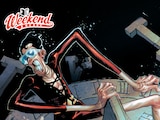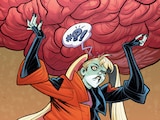“Who watches the Watchmen?”
It’s a question posed famously in 1986’s Watchmen series and echoed throughout DC comic books for many years afterward. It asks who keeps an eye on the heroes who are meant to watch over us, interrogating their state of mind and the very nature of what makes such a person. Several comic storylines sought to redefine popular heroes, and in 1992, Alan Grant approached the topic with the launch of what was DC’s fourth ongoing Batman title, Batman: Shadow of the Bat, and its opening four-part story “The Last Arkham.”

In “The Last Arkham,” writer Alan Grant and penciller Norm Breyfogle, who previously worked on Detective Comics in the early ’90s – introduce Jeremiah Arkham, the new head of Arkham Asylum and nephew of the institute’s founder, Amadeus Arkham. Jeremiah destroys the previous building and has the inmates moved to a state-of-the-art institution, replete with microwave emitters, round-the-clock security cameras and a bevy of muscled guards. Over the course of the first issue, we’re presented with Jeremiah’s outlook on mental health, human behavior, and the maintenance of sanity in a civilized world. Drawing heavily upon the work from Psychologist B.F. Skinner, Arkham repeats throughout the four issues that actions are more consequential than thoughts, and that “If you change the behavior, the mind will follow.”
It’s soon revealed how far he’s willing to go to make those changes, as we see various members of the Gotham Rogues Gallery subjected to specific tortures such as frightful holograms, machines that prevent them from sleeping and isolation chambers. All of this leads up to the reveal that the newest inmate at the refurnished Arkham is none other than Batman. Determined to break the Dark Knight whom he claims to be just another crazy person, Arkham keeps Batman in chains and has his men work their batons and bats on him before blasting him with a firehose.

“The Last Arkham” works in two ways. First, it serves as a solid detective story. A series of grisly murders have sprung up in Gotham that match the M.O. of a noted serial killer, and Batman and Commissioner Gordon work to determine if the killer has escaped Arkham or if there’s a copycat. Secondly and most memorably, however, is the focus on the razor-thin line of sanity in Gotham City, and who is fit to apply it in such a violent and unpredictable world.
Jeremiah Arkham is a decidedly brutal, cold-hearted keeper of those he claims are victims of their own psychosis. He keeps his inmates chained by the neck, attacks them via holograms of their own personal fears and phobias, and even turns them into servants to prove the efficacy of his methods. When Batman repeatedly tests the mettle of his security force, Arkham releases all of his imprisoned inmates to beat Batman into submission, knowing that the hate his enemies carry for the Dark Knight would likely result in his death, yet he maintains it’s purely for science. He describes his methods as necessary to better the inmates’ capacity for sanity and even sleeps at the asylum to preserve an avuncular presence over his charges. Yet Arkham’s actions are plainly sadistic and are described as such by Batman who ultimately posits that Arkham is just as insane as any super-villain. That he’s stared in the heart of madness for too long to come out the other side unscathed.

“The Last Arkham” is also known for the other major villain it introduces, the horrific Mr. Zsasz. An utter madman who kills indiscriminately with a knife, Zsasz’s signature methods of slashing his victims, posing them in lifelike postures and carving tally marks into his own skin to keep score of the murders he’s committed are all on display in frightening fashion by artist Norm Breyfogle. Referring to the living as “zombies,” Zsasz is one of the most twisted antagonists Batman’s ever gone up against, without the delusions of his psychosis preventing him from exhibiting ingenuity. Part of the mystery is learning if Zsasz is truly the culprit Batman is after, and how he might escape Arkham’s newly installed security force. It’s a riddle taken up by both Batman and Nightwing, who comes to Gotham once news spreads that Batman is being held prisoner.
Finally, there’s the indelible artwork of Norm Breyfogle that stays with the reader long after they finish the story. The image of Batman chained up in an insane asylum is too powerful to deny, wrenched up to ten with Breyfogle’s full-page splashes of Batman yanking at his chains, entirely off the ground, screaming “I AM NOT INSANE!”

In this story, we have Jeremiah Arkham, a psychologist with extreme and violent methods. We have Mr. Zsasz, a murderer. But Batman is often depicted with muscles strained, teeth gritted and eyes narrowed so far down they look almost inhuman. We believe going into the story the mind of Batman isn’t as far gone as those of his adversaries, but do we know it? Arkham raises enough doubt in Batman’s mind to provoke him—and us, the readers—into reflecting on just how little his crimefighting persona differentiates from those of the people he’s fighting. The costume, the theme, the violence—they all parallel each other. Are Batman’s suspicions and deductive reasonings examples of his intelligence…or his madness?
Both Zsasz and Arkham are shown throughout the story to be very intelligent, well-read men. A key signifier of what keeps Batman prevailing over evil is his wit and cunning, but when compared to forces with similar minds, the dark side creeps into view.
In “The Last Arkham,” Alan Grant and Norm Breyfogle created an essential Batman story that succinctly redefines everything great about the Caped Crusader while holding his legend under an intriguing lens of psychoanalysis and dissection. With the recent passing of Mr. Grant, both creators have now sadly left us. But they leave behind some of the finest work ever to grace the comic book industry. If you’ve not read Shadow of the Bat #1-#4, there’s no time like the present to celebrate Grant and Breyfogle’s legacy while treating yourself to a true under-the-radar classic. You’ll be glad you did.
"The Last Arkham" by Alan Grant and Norm Breyfogle is available to read in full on DC UNIVERSE INFINITE.
Donovan Morgan Grant writes about comics, graphic novels and superhero history for DCComics.com. Follow him on Twitter at @donoDMG1.




















